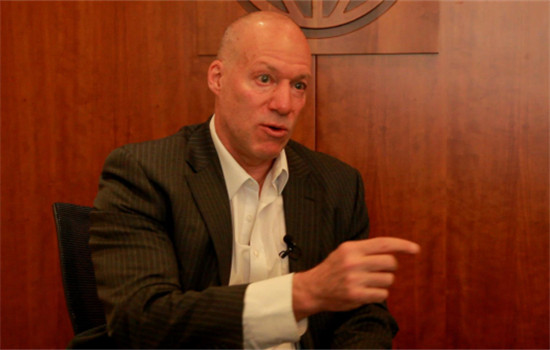
John Litwack, the World Bank's lead economist for China, is interviewed by the China Daily website. (Photo by Cong Ruiting/chinadaily.com.cn)
Editor's Note: In a wide-ranging interview with the China Daily website, John Litwack, the World Bank's lead economist for China, commented on China's Q3 data and discussed the opportunities and challenges both China and the world face in 2017. He emphasized that as China can still achieve high growth and deleveraging, the welfare of the Chinese people could continue to grow very quickly.
1. What's your evaluation of the Q3 data? Many analysts note that the PPI, the producer price index, which gauges factory-gate prices, rose by 0.1 percent year-on-year in September after falling in China since March 2012. Does the PPI growth hint reform measures are taking effect?
The 2016 Q3 numbers look good generally. China has maintained 6.7% growth. Despite having some slowdown in July, growth picked up in August and September. One thing we look at when you see China's growth is that output growth seems to follow credit growth so closely, so we also have seen a sign of acceleration in the growth of credit in August and September. The fact that the pace of growth in credit more than twice that of GDP raises questions of sustainability. But when we look at the indicators like PMI, the Chinese economy is doing pretty well in terms of growth and in terms of outlook for business.
When you look at the PPI, it is common to cite the year on year number, and it's true that that number had been negative until very recently. But if you look at the monthly numbers, the PPI has actually been positive for all of this year, We think that is a good sign, a negative PPI would be a negative sign for the economy that problems like over-capacity. There are two primary factors that can explain the recent changes in the PPI: one is commodity prices. One reason why the PPI has been very low and negative in recent years is that commodity prices have been falling. Alternately, one reason why the PPI turned positive this year is because of a recovery in the prices of commodities like oil, steel and coal in of world markets.
The second factor is progress in China's reforms, in particular addressing excess capacity issues. That's very important.
There's still a future for the coal and steel industries, but perhaps a smaller role. So in part the reform is about downsizing the most inefficient parts of these industries, and rebalancing the economy to other sectors, which is obviously a difficult process because it involves a lot of workers and some areas of China very much depend on these sectors. It's a difficult process for any country to move concentration from one sector to another. But we hope that China will continue to progress in this area. We're working with the Chinese government to develop instruments to help support and re-train workers from these over-capacity industries so they can work productively elsewhere.


















































